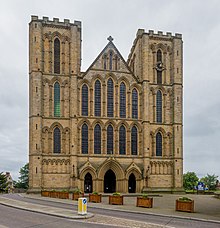Ripon Minster
| Ripon Cathedral | |
|---|---|

The west end of the cathedral
|
|
| Coordinates: 54°8′5″N 1°31′12″W / 54.13472°N 1.52000°W | |
| Location | Ripon, North Yorkshire |
| Country | England |
| Denomination | Church of England |
| Tradition | Anglo-Catholic |
| Website | www.riponcathedral.org.uk |
| Architecture | |
| Status | Cathedral (since 1836) |
| Functional status | Active |
| Heritage designation | Grade I |
| Style | Anglo-Saxon, Gothic (Early English) |
| Years built | 1160–1547 |
| Administration | |
| Diocese | Leeds (since 2014) |
| Province | York |
| Clergy | |
| Dean | John Dobson |
| Precentor | Paul Greenwell |
| Canon(s) | Elizabeth Sewell (Canon Pastor & Canon Educator) |
| Laity | |
| Director of music | Andrew Bryden |
| Organist(s) | Tim Harper |
Ripon Cathedral is a cathedral in the North Yorkshire city of Ripon. Originally founded by St Wilfrid in 672, the church is currently a seat of the Bishop of Leeds, and since 2014 has been one of three co-equal mother churches of the Diocese of Leeds. From 1836 to 2014 the church was the cathedral of the Diocese of Ripon, and during the Middle Ages acted as a mother church within the large Diocese of York. The cathedral has Grade I listed building status.
There has been a stone church on the site since 672 when Saint Wilfrid replaced the previous timber church of the monastery at Ripon (a daughter house of Saint Aidan's monastery at Melrose) with one in the Roman style. This is one of the earliest stone buildings erected in the Anglo-Saxon Kingdom of Northumbria. The crypt dates from this period.
People have been coming to worship and pray at Ripon for more than 1,350 years. The Cathedral building itself is part of this continuing act of worship, begun in the 7th century when Saint Wilfrid built one of England's first stone churches on this site, and still renewed every day. Within the nave and choir, you can see the evidence of 800 years in which master craftsmen have expressed their faith in wood and stone.
Today's church is the fourth to have stood on this site. Saint Wilfrid brought stonemasons, plasterers and glaziers from France and Italy to build his great basilica in AD 672. A contemporary account by Eddius Stephanus tells us:
...
Wikipedia

